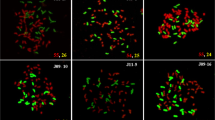Summary
Somaclonal variation from a partially sterile intergeneric hybrid was obtained for sugarcane improvement and for understanding phylogeny. Over 1,000 somaclones were regenerated from callus cultures of intergeneric hybrid clone H83-9998 (2n = ca. 94) involving H62-4671 (Saccharum spp. hybrid, 2n = ca. 115) x 28NG7 (Erianthus arundinaceum, 2n = 60) as parents. One hundred twenty-six somaclones were selected on the basis of observed morphological variation and planted in large plots with the original hybrid and its parental clones for detailed studies. Data were collected for stalk (number, length, diameter), leaf (length, width) and sucrose characters. Obvious variations in dewlap shape, leaf and stalk colors, leaf angle, rhizome habit, and pollen fertility, as well as date of flowering, were recorded. Chromosome and isozyme analyses were conducted to confirm that the observed phenotypic variation among somaclones had a genetic basis. Chromosome numbers of somaclones selected on the basis of phenotypic variation ranged from 2n = 66 to 2n = 109. With isozyme analysis, 1 to 4 band variations in three systems (peroxidase, phosphoglucomutase, and phosphoglucoisomerase) were found. Significant genetic variance estimates (σG2/σP2) and genetic CVs (6.7–25.6%) indicate that the differences observed among somaclonal variants would likely remain stable in additional asexually propagated cycles. Yield was estimated from stalk volume x refractometer solids, and 9 out of 126 somaclones produced higher estimates yield than the hybrid. One somaclone showed estimated yield that was not significantly different from the Saccharum parent.
Similar content being viewed by others
References
Ahloowalia, B.S., 1965. A root tip squash technique for screening chromosome number in Lolium. Euphytica 14: 170–172.
Brown, A.H.D., J. Daniels & B.D.H. Latter, 1969. Quantitative genetics of sugarcane II. Correlation analysis of continuous characters in relation to hybrid sugarcane breeding. Theor. Appl. Genet. 39: 1–10.
Cardy, B.J., C.W. Stuber, J.F. Wendel & M.M. Goodman, 1980. Techniques for starch gel electrophoresis of enzymes from maize (Zea mays L.). Inst. of Stat. Mimeo Ser. No. 1317. North Carolina State University.
Graham, R.C., U. Lundholm & M.J. Karnovsky, 1964. Cytochemical demonstration of peroxidase activity with 3-amino 9-ethylcarbazole. J. Histochem. 13: 150–152.
Heinz, D.J., 1973. Sugarcane improvement through induced mutations using vegetative propagules and cell culture techniques. FAOIIAEA Panel Proc. Induced Mutations in Vegetatively Propagated Plants. PL 501/5, 53–59.
Heinz, D.J., M. Krishnamurthi, L.G. Nickell & A. Maretzki, 1977. Cell, tissue and organ culture in sugarcane improvement. In: J. Reinert & Y.P.S. Bajaj (Eds), Applied and fundamental aspects of plant cell, tissue and organ culture. Springer-Verlag, Berlin Heidelberg New York, pp. 3–248.
Heinz, D.J. & G.W.P. Mee, 1969. Plant differentiation from callus tissue of Saccharum species. Crop. Sci. 9: 346–348.
Kang, M.S., J.D. Miller & P.Y.P. Tai, 1984. Clonal and individual repeatability of agronomic traits in sugercane. Proc. American Soc. of Sugarcane Technologists 3: 22–27.
Larkin, P.J. & W.R. Scowcroft, 1981. Somaclonal variation—a novel source of variability from cell cultures for plant improvement. Theor. Appl. Genet. 60: 197–214.
Meyer, H.K., D.J. Heinz & S.L. Ladd, 1974. Yield Components. Ann. Rep. Exp. Stn. Hawaiian Sugar Planters' Assoc., pp. 10–11.
Miller, J.D. & N.I. James, 1974. The influence of stalk density on cane yield. Int Soc Sugar Cane Technol Breeders' 15th Congr. Proc., pp 177–184.
Milligan, S.B., K.A. Gravois, K.P. Bischoff & F.A. Martin, 1990. Crop effects on genetic relationships among sugarcane traits. Crop Sci. 30: 927–931.
Nagai, C., B.S. Ahloowalia, D.J. Heinz & T.L. Tew, 1986. Colchicine-induced aneuploids from cell culture of sugar-cane. Euphytica 35: 1029–1038.
Orton, T., 1980. Chromosome variability in tissue cultures and regenerated plants of Hordeum. Theor. Appl. Genet. 56: 101–112.
Sreenivasan, J. & T.V. Sreenivasan, 1984. In vitro propagation of a Saccharum officinarum (L) and Sclerostachya fusca (Roxb.) A Camus Hybrid. Theor. Appl. Genet. 67: 171–174.
Sreenivasan, T.V. & N.C. Jalaja, 1982. Production of subclones from the callus culture of Saccharum-Zea hybrid. Plant Sci. Lett. 24: 255–259.
Sreenivasan, T.V., B.S. Ahloowalia & D.J. Heinz, 1987. Cytogenetics. In: D.J. Heinz (Ed.), Sugarcane improvement through breeding. Elsevier, Amsterdam, pp 211–253.
Wendel, J.F. & C.R. Parks, 1982. Genetic control of isozyme variation in Camelia japonica L. J. Heredity 73: 197–204.
Author information
Authors and Affiliations
Additional information
Published as Paper No. 737 in the Journal Series of the Experiment Station, Hawaiian Sugar Planter's Association, Aiea, HI 96701.
Rights and permissions
About this article
Cite this article
Nagai, C., Ahloowalia, B.S. & Tew, T.L. Somaclonal variants from an intergeneric hybrid: Saccharum spp. hybrid x Erianthus arundinaceum . Euphytica 53, 193–199 (1991). https://doi.org/10.1007/BF00023271
Received:
Accepted:
Issue Date:
DOI: https://doi.org/10.1007/BF00023271




